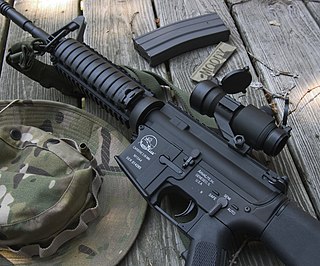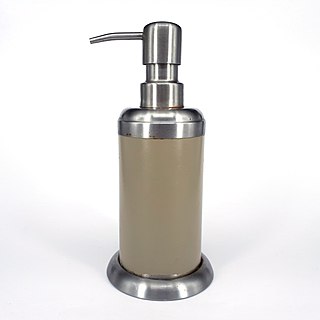A stomp rocket is a flying toy rocket that is powered by the release of compressed air.
The rocket has a hollow body that fits over a launch tube. The launch tube is a hollow, rigid pipe, with an opening into the rocket body, and a connection to a pipe that is connected to an air bladder. Typical bladders are an air pump, or a flexible bottle (e.g. plastic drink bottle).
When pressure is applied to the bladder (compressing the container) the air contained within is expelled from the bladder. In many home made versions, the bladder is a recycled drinks bottle, from which air is released rapidly by the user jumping, or 'stomping' on the bottle - hence "stomp rocket". The expelled air rushes through the connecting pipe and into the body of the rocket, causing a pressurisation of the air in the rocket's hollow body. The air within the rocket body has to escape, and is expelled to the rear of the rocket, causing the rocket to accelerate upwards along the launch tube in the opposite direction, and then lift into the sky.
The launch tube may be mounted on an adjustable clamp to enable the direction of the launch to be set by the user.
The thrust of a stomp rocket is completely expended in the first instance of flight. For the majority of the flight, only Gravity and aerodynamic forces act on the rocket, unlike on a Water rocket or a 'real' rocket with motors and fuel onboard, which are applying thrust force to the rocket for a large portion of the flight.
The Astroblast was a late 1970s-era toy rocket consisting of a plastic chamber with a plunger on top.[ citation needed ] An adjustable plastic pipe allowed a foam rubber rocket to be launched at any angle when the user stomped on the plunger. A later adaptation of the Astroblast substituted an air pump and release mechanism for the stomp chamber and plunger.
Stomp Rocket is a trademarked name, the owner being Fred Ramirez, President of D&L Company. D&L manufactured their first stomp rocket ever in the early 1990s. There are five versions of D&L Stomp rockets available: the Super High-Performance Stomp Rocket, which travels about 400 feet, the Ultra Stomp Rocket, which travels about 200 feet, the Ultra LED Stomp Rocket, which travels about 100 feet, the Ultra Dueling Stomp Rocket, which travels about 200 feet, and the Junior Stomp Rocket, which travels about 100 feet. The highest stomp rocket ever was 1/4 of a mile in the air. The Rocket is mainly based on the concept of air pressure and sounding rockets

A pump is a device that moves fluids, or sometimes slurries, by mechanical action, typically converted from electrical energy into hydraulic energy.

A ramjet, or athodyd, is a form of airbreathing jet engine that uses the forward motion of the engine to take in air for combustion that produces jet thrust. Since it produces no thrust when stationary ramjet-powered vehicles require an assisted take-off like a rocket assist to accelerate it to a speed where it begins to produce thrust. Ramjets work most efficiently at supersonic speeds around Mach 3 and can operate up to speeds of Mach 6.

A syringe is a simple reciprocating pump consisting of a plunger that fits tightly within a cylindrical tube called a barrel. The plunger can be linearly pulled and pushed along the inside of the tube, allowing the syringe to take in and expel liquid or gas through a discharge orifice at the front (open) end of the tube. The open end of the syringe may be fitted with a hypodermic needle, a nozzle or tubing to direct the flow into and out of the barrel. Syringes are frequently used in clinical medicine to administer injections, infuse intravenous therapy into the bloodstream, apply compounds such as glue or lubricant, and draw/measure liquids. There are also prefilled syringes.
Air-augmented rockets use the supersonic exhaust of some kind of rocket engine to further compress air collected by ram effect during flight to use as additional working mass, leading to greater effective thrust for any given amount of fuel than either the rocket or a ramjet alone.

A skyrocket is a type of firework that uses a solid-fuel rocket to rise quickly into the sky; a bottle rocket is a small skyrocket. At the apex of its ascent, it is usual for a variety of effects to be emitted. Skyrockets use various stabilisation techniques to ensure the flight follows a predictable course, often a long stick attached to the side of the motor, but also including spin-stabilisation or fins.
Toy guns are toys which imitate real guns, but are designed for recreational sport or casual play by children. From hand-carved wooden replicas to factory-produced pop guns and cap guns, toy guns come in all sizes, prices and materials such as wood, metal, plastic or any combination thereof. Many newer toy guns are brightly colored and oddly shaped to prevent them from being mistaken for real firearms.
A propellant is a mass that is expelled or expanded in such a way as to create a thrust or another motive force in accordance with Newton's third law of motion, and "propel" a vehicle, projectile, or fluid payload. In vehicles, the engine that expels the propellant is called a reaction engine. Although technically a propellant is the reaction mass used to create thrust, the term "propellant" is often used to describe a substance which contains both the reaction mass and the fuel that holds the energy used to accelerate the reaction mass. For example, the term "propellant" is often used in chemical rocket design to describe a combined fuel/propellant, although the propellants should not be confused with the fuel that is used by an engine to produce the energy that expels the propellant. Even though the byproducts of substances used as fuel are also often used as a reaction mass to create the thrust, such as with a chemical rocket engine, propellant and fuel are two distinct concepts.

A water gun is a type of toy gun designed to shoot jets of water. Similar to water balloons, the primary purpose of the toy is to soak another person in a recreational game such as water fight.

A water rocket is a type of model rocket using water as its reaction mass. The water is forced out by a pressurized gas, typically compressed air. Like all rocket engines, it operates on the principle of Newton's third law of motion. Water rocket hobbyists typically use one or more plastic soft drink bottle as the rocket's pressure vessel. A variety of designs are possible including multi-stage rockets. Water rockets are also custom-built from composite materials to achieve world record altitudes.

A jet pack, rocket belt, or rocket pack is a device worn on the back which uses jets of gas or liquid to propel the wearer through the air. The concept has been present in science fiction for almost a century and became widespread in the 1960s.

Airsoft guns are replica toy guns used in airsoft sports. They are a special type of low-power smoothbore air guns designed to shoot non-metallic spherical projectiles (pb) often colloquially referred to as "BBs", which are typically made of plastic or biodegradable resin materials. Airsoft gun powerplants are designed to have low muzzle energy ratings and the pellets have significantly less penetrative and stopping powers than conventional airguns, and are generally safe for competitive sporting and recreational purposes if proper protective gear is worn.

The Bell Rocket Belt is a low-power rocket propulsion device that allows an individual to safely travel or leap over small distances. It is a type of rocket pack.

A radio-controlled submarine is a scale model of a submarine that can be steered via radio control. The most common form are those operated by hobbyists. These can range from inexpensive toys to complex projects involving sophisticated electronics. Oceanographers and military units also operate radio-controlled submarines.

A soap dispenser is a device that, when manipulated or triggered appropriately, dispenses soap. It can be manually operated using a handle or can be automatic. Soap dispensers are often found in public toilets.

A jack is a mechanical lifting device used to apply great forces or lift heavy loads. A mechanical jack employs a screw thread for lifting heavy equipment. A hydraulic jack uses hydraulic power. The most common form is a car jack, floor jack or garage jack, which lifts vehicles so that maintenance can be performed. Jacks are usually rated for a maximum lifting capacity. Industrial jacks can be rated for many tons of load.

A potato cannon is a pipe-based cannon that uses air pressure (pneumatic), or combustion of a flammable gas, to launch projectiles at high speeds. They are built to fire chunks of potato, as a hobby, or to fire other sorts of projectiles, for practical use. Projectiles or failing guns can be dangerous and result in life-threatening injuries, including cranial fractures, enucleation, and blindness if a person is hit.

A squeeze bottle is a type of container such as a plastic bottle for dispensing a fluid, that is powered by squeezing the container by exerting pressure with the user's hand. Its fundamental characteristic is that manual pressure applied to a resilient hollow body is harnessed to compress fluid within it and thereby expel the fluid through some form of nozzle.

A balloon is a flexible bag that can be inflated with a gas, such as helium, hydrogen, nitrous oxide, oxygen, and air. For special tasks, balloons can be filled with smoke, liquid water, granular media, or light sources. Modern day balloons are made from materials such as rubber, latex, polychloroprene, or a nylon fabric, and can come in many different colors. Some early balloons were made of dried animal bladders, such as the pig bladder. Some balloons are used for decorative purposes or entertaining purposes, while others are used for practical purposes such as meteorology, medical treatment, military defense, or transportation. A balloon's properties, including its low density and low cost, have led to a wide range of applications.
High-density solids pumps are hydrostatically operating machines which displace the medium being pumped and thus create a flow.
A Cricketsonde (Cold Rocket Instrument Carrying Kit sonde) was a CO2 propelled, low-altitude meteorological rocket designed in the early 1960s by Texaco Inc. and the Friez Instrument Division of Bendix Corporation. It was used by various government and academic agencies until at least the late 1960s. The rocket carried what was essentially a radiosonde payload and was capable of reaching over 3,000 feet (910 meters), where it then ejected a parachute and sent telemetry about temperature, humidity and barometric pressure during descent. A ground station with a manually tracked antenna received the signal where the data was processed and recorded.